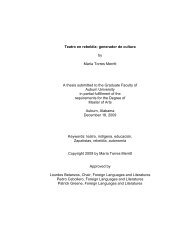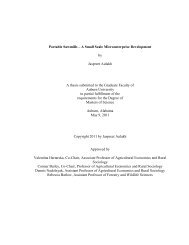Enhanced Polymer Passivation Layer for Wafer Level Chip Scale ...
Enhanced Polymer Passivation Layer for Wafer Level Chip Scale ...
Enhanced Polymer Passivation Layer for Wafer Level Chip Scale ...
Create successful ePaper yourself
Turn your PDF publications into a flip-book with our unique Google optimized e-Paper software.
5.1.1 Modeling Approaches<br />
Due to the variations in material properties, modeling assumptions and inconsistencies in<br />
the FE modeling process itself, analyzing the complete assembly generally takes significant time<br />
and sometimes may be beyond the computing capability. There<strong>for</strong>e, insuring 100% simulation<br />
accuracy in a solder joint fatigue model is a difficult task. However, the accuracy still needs to be<br />
guaranteed such that it can provide a positive impact on the designed package per<strong>for</strong>mance [83].<br />
In addition to the application of 2-dimensional finite element model, 3-dimensional modeling has<br />
been widely used in the industry <strong>for</strong> solder joint life prediction as it physically describes the<br />
structure and there<strong>for</strong>e improves the accuracy over 2D modeling. These common 3D modeling<br />
approaches can be grouped as Global modeling, Sub-structure modeling, Sub-modeling, and<br />
Slice modeling [84].<br />
1. Global modeling<br />
The global modeling approach is widely used to capture the local solder joint behavior.<br />
All of the materials and their respective non-linearities are included in the simulation analysis.<br />
The objective is to use a very detailed model of the critical joint while transmitting the correct<br />
load vector and assembly stiffness from the rest of the structure to this model. As shown in<br />
Figure 5.1, the global model uses a relatively coarse mesh <strong>for</strong> all of the components except <strong>for</strong><br />
the critical solder joints. However, it is still time consuming to obtain accurate analysis results<br />
because the fine mesh of the critical solder joints must match to the coarse mesh of the remaining<br />
solder joints.<br />
95
















